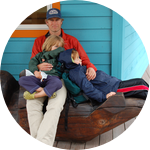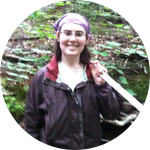About This Project
Carbon, nitrogen and phosphorous are scarce in headwater streams. When insects emerge from these streams and are consumed by forest birds and spiders, they take these elements with them. I am investigating if salamander communities help keep these nutrients in the stream by eating stream insects before they can emerge and, if so, how this affects the base of stream food webs.
Ask the Scientists
Join The DiscussionWhat is the context of this research?
A subsidy is a resource that is controlled by one ecosystem but provides fuel for another. For example emerging stream insects are eaten by forest birds. Little is known about the cost to an ecosystem of providing a subsidy, particularly in resource-poor systems. When subsidies are living animals predators can eat them, interrupting the subsidy and preventing the loss of resources. I hypothesize that this retention of resources may increase productivity in the system providing the subsidy. My research looks at two species of stream salamanders and if they decrease insect emergence—a subsidy from stream to forest—when they occur singularly or together in streams, and if this increases biofilm—the mixture of algae and bacteria at the base of stream food webs.
What is the significance of this project?
My work will help us better understand the cost to an ecosystem in terms of its productivity, of providing subsidies and the role predator communities have in regulating those subsidies. I work with stream salamanders in the Hubbard Brook Experimental Forest (HBEF) in New Hampshire (http://www.hubbardbrook.org/). Salamander communities vary greatly across HBEF. This allows me to see how changes in predator communities (salamander species) alters subsidies (emerging insects) and stream productivity (biofilm). For more on my project see my blog post at http://wildlifebiologymontana.tumblr.com/. By quantifying the stream salamander communities at HBEF, and their effects on biofilm and emerging insects, I am also helping a broad group of researchers create an energy budget for HBEF.
What are the goals of the project?
In 2015 and 2016 I collected 825 insect samples and 109 biofilm samples from 27 sections of stream across the Hubbard Brook valley. I have processed 281 of my insect samples. I will use part of the funds I raise to hire an undergraduate student to help me weigh and identify my remaining insect samples. These samples will show how insect emergence changes with different salamander communities. I will use the rest of the funds to analyze my biofilm samples for ash free dry mass, a measure of the algae and bacteria in each sample. I am using biofilm as a measure of stream productivity. I collected each biofilm sample from a set surface area, allowing me to compare biofilm between streams. I expect to see increases in biofilm as insect emergence decreases and more resources stay in the stream.
Budget
I will use $683 of the funds I raise on Experiment to provide a stipend for an undergraduate student to help me weigh and identify my insect samples down to the taxonomic level of family. This student will work with me for five hours a week over the course of fifteen weeks. This student will gain valuable lab experience as well as one-on-one mentoring on insect identification. I expect this student will be able to weigh 109 insect samples I and identify 72 insect samples. This will leave 219 samples to weigh and 144 samples to identify, which I will process myself. I will use the remaining $377 to analyze the ash free dry mass of my 109 biofilm samples. The cost of laboratory space and material for this process is $3 per sample plus a $50 training fee for a total of $377.
Endorsed by
Meet the Team
Clarice Bayer
I am a doctoral candidate in the Wildlife Biology Program at the University of Montana. I earned my BA in biology from Washington and Lee University in 2007. While earning my BA I studied the genetics of a newly discovered salamander species, leading to a paper published in Conservation Genetics on which I am first author (http://link.springer.com/article/10.1007/s10592-011-0297-7). Post-graduation I spent several months in Brazil studying the correlation between fish shape and habitat preference. I was second author on the resulting paper recently published in the Brazilian Journal of Biology (http://www.scielo.br/scielo.php?pid=S1519-69842016005116108&script=sci_arttext). When not in the lab I enjoy poking around in streams and bringing back specimens for my freshwater fish tank.
Project Backers
- 24Backers
- 100%Funded
- $1,061Total Donations
- $42.44Average Donation

